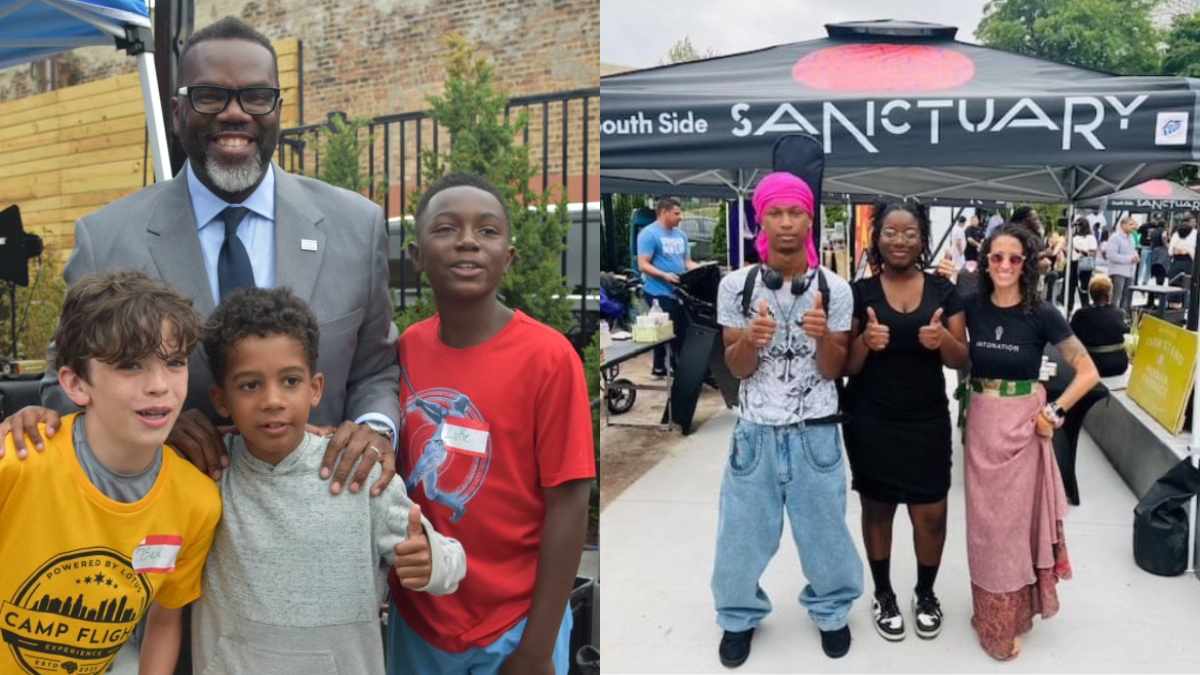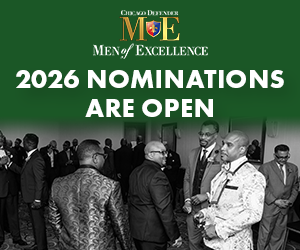Mayor Brandon Johnson and some young attendees at the ribbon cutting for the new South Side Sanctuary in Bronzeville (Photo Credit: Lanette Warbington).
Cecilia Cuff, CEO of the Nascent Group and co-founder of South Side Sanctuary, believes that “spaces of love can actively heal our community.”
Standing on a formerly vacant lot on the southwest corner of 47th and King Drive, the South Side Sanctuary is a 13,000-square-foot green space featuring a stage, grassy knolls for picnics and parties, outdoor classrooms, and a market space.
Its community-led programming will be presented under four pillars: Integrative Wellness, Entrepreneurship and Innovation, Arts and Culture, and Sports and Recreation.
According to Department of Planning & Development Commissioner Ciere Boatright, the City acquired the lot back in 1998. Several proposals were issued for the land, but none came to fruition due to funding and coordination.
Since the idea’s inception, the South Side Sanctuary team has intentionally partnered with the community during regular stakeholder meetings. The meetings will transition to monthly occurrences, during which residents can weigh in on what they want to see happening in the space.
Jasmine Anwuli Michaels, the South Side Sanctuary’s co-founder, shared that the community meetings unearthed a lot of issues that many people faced. This helped create a foundation for how this space would provide for those in need.
“Many struggle with mental health challenges, with loneliness, anxiety, with depression, losing friends to suicide. Challenges at work, home, divorce. This space is a healing space for those very real issues.”
The South Side Sanctuary received a $710,000 grant as the final recipient of 11 Public Outdoor Plaza sites to open in Chicago. POP! is a City of Chicago Department of Planning and Development initiative that began in 2021, with the first site in the Austin community. Funding was made possible by the 2021 American Rescue Act.
Nestled in the heart of Bronzeville, the Sanctuary is an opportunity to “reverse our city’s history of disinvesting in our neighborhoods,” said Mayor Brandon Johnson, who attended the space’s ribbon-cutting ceremony.

Ribbon-cutting ceremony for South Side Sanctuary (Photo Credit: Lanette Warbington).
Bronzeville, known as the Black Metropolis, was once the center of Black commerce and culture. Cuff hopes the Sanctuary will be a magnet to attract foot traffic to patronize local businesses along 47th Street.
“[This will be] a thriving beacon on the Southside as it once was nearly 100 years ago where every single building on this block had a business,” said Cuff.
This site is an example of creative placemaking, an urban planning strategy used to highlight a community’s strength and culture. Cuff and her team intend for the South Side Sanctuary to serve as a national model for activating empty spaces.
They plan to measure the economic and safety impact of the project, produce a free resource manual for creating similar projects in under-resourced neighborhoods across the country, and develop more community spaces throughout Chicago modeled after the Sanctuary.
This project stretched Ald. Pat Dowell’s (3rd) notion of viable urban development. Dowell, whose ward the Sanctuary is located in, has an extensive urban planning and community development background and typically thinks of brick and mortar to revitalize communities.
“But that’s not always the best way,” she said. Sometimes, you have to rejuvenate the community’s heart, spirit, and passion.”
Dowell revealed that the Sanctuary is just the beginning of what’s to come to the 47th Street Corridor.
“This is a catalyst for a lot of things that will be happening on 47th Street:
Future housing for the LGBTQ community, housing for the elderly. We’re vetting through DPD and the Mayor’s Office for two mixed-use housing and commercial development on Vincennes.”
Mayor Johnson believes that the healing will make space for “economic vibrancy.”
The more people that are in these spaces, the more confidence people will have in our communities, which will spur the type of investments that I said I’d do from the very beginning.”



